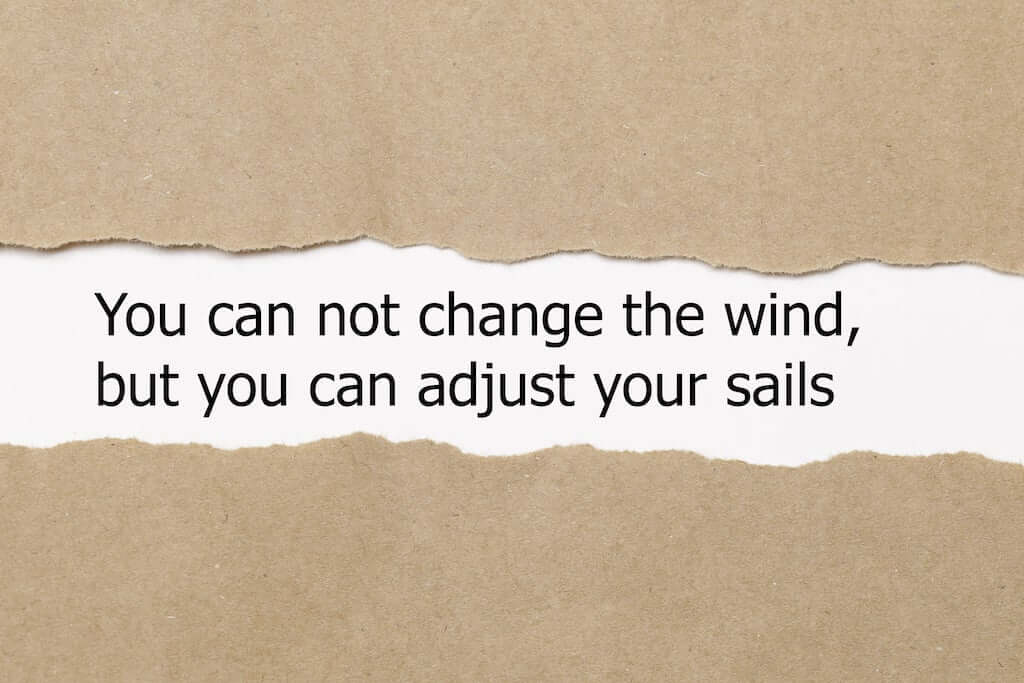Sustainable Caregiving Strategies
Strategy: Setting Boundaries
Caregiving changes our relationships. If our care recipient is our parent, our relationship shifts from parent / adult child to caree / caregiver. It may be a gradual shift over several years or a sudden shift in the case of a hospitalization or a disease diagnosis. Regardless of the pace of progression, responsibilities change over time and these changing responsibilities require that we reassess our boundaries. If you haven’t given much thought to boundaries prior to now, this is the time to reevaluate roles, relationships and limits so that you, and those traveling with you on your caregiving journey, feel respected and supported.

“Compassionate people ask for what they need. They say no when they need to, and when they say yes, they mean it. They’re compassionate because their boundaries keep them out of resentment.”
Brené Brown
Boundaries protect us from burnout. In addition to relationships changing with your care recipient, relationships change with siblings and friends. Boundaries will help you determine who is on your care team and who is only adding drama to the experience. You will find yourself in the new role of communicating and coordinating care for your family member and it can feel awkward and intimidating. Boundaries will help you manage professional interactions with people who are helping with the intimate act of providing care for your family member.
What are boundaries:
Boundaries may be set to protect our time, our emotions, our energy, our compassion reserves, and our values. When we set and communicate boundaries, we are respecting ourselves and others.
Boundaries are:
- limits that we set to protect our physical and emotional well-being
- guidelines and rules that are communicated to define what behaviors you will accept from those around you and what your response will be if your boundary is crossed
- rules that help us define who we are and what we believe to be our responsibilities
- set around communication, interaction, and behavior

Why setting boundaries is important:
We may start by helping our parent a few days a week. Two days a week can unwittingly slip into assisting with daily activities. Bit by bit, we can start to give up our hobbies and interests until we are entrenched without a clear way out from under the tasks. What starts as rewarding and fulfilling work becomes oppressive and frustrating when we don’t keep our life. Keeping our life means protecting our other relationships and protecting ourselves from burnout. In this way, boundaries are a form of self-care. Boundaries in caregiving are important even with the best relationship history. When our roles shift dramatically, it is important to mindfully redefine responsibilities so that we don’t let our generosity lead to feelings of resentment.
Boundaries prevent burnout:
Healthy boundaries help us maintain healthy relationships. Caregiver burnout occurs when we have given too much of ourselves. Establishing boundaries is a way to communicate our needs. Boundaries offer the opportunity to be more in control of our time and how we spend it. Without boundaries, the overwhelm of caregiving can feel like being in the middle of a storm of emotions. Setting boundaries is a way of respecting ourselves and protecting ourselves from the storm. When you choose when to give, you save enough of you so that you are able to give when you choose.
Why setting boundaries is hard:
There are several barriers to setting boundaries. A common barrier is that we have not been taught how to set boundaries and therefore don’t recognize the need. Another barrier occurs when we realize a boundary is necessary, but feel guilty about setting the boundary. Similarly, we set a boundary and it is rejected or resisted. We may be told that we are selfish for setting the boundary, leading to guilt and confusion about the validity of the boundary. It is possible that we are interacting with someone who does not set their own boundaries or respect those set by others. In this case, consistent reinforcement may be challenging due to uncomfortable confrontations. These uncomfortable confrontations may cause us to ignore a crossed boundary.
“Daring to set boundaries is about having the courage to love ourselves even when we risk disappointing others.“
Brené Brown
While setting boundaries can feel selfish, the opposite is true. Well maintained boundaries are a gift to yourself and those in your caregiving circle. The confidence to stand firm will come from being clear in your intention and in your communication. Practice will make the process easier.
Communicating boundaries:
When you start to feel guilty about setting the boundary, remind yourself that setting boundaries is not selfish, but an important part of your self-care as a caregiver. These boundaries will allow you to sustain yourself as you provide care. They will protect your compassion reserves, so that you are able to provide the care that is in line with your values.
Tips for effective communication:
- Be clear on your intention so that you can be clear in your communication
- Respectfully and with as few words as possible, communicate your boundary
- Word the request in terms of what you need and why you need it rather than using the word “you”. For example, “I need some space…” rather than, “You need to stop…”.
- Share the consequences if the boundary is crossed
- Be firm and unapologetic
Too rigid, too flexible, just right:
If we are comfortable saying “no” and accepting a “no” from others, then we understand and respect healthy boundaries. It may be that you are skilled at setting healthy boundaries at work, but are less confident setting boundaries with family and friends. Learning to set and maintain boundaries in a new setting takes awareness and practice. With practice, we can determine when boundaries are too rigid, too flexible, or just right.
For example, there are varying degrees to which we can “open up” to people and share personal information. The extreme ends of sharing are “rarely opening up” vs “oversharing”. Somewhere in the middle is where healthy boundaries are formed. Another example of too rigid vs too flexible is never asking for help vs never saying no to a request for help. A boundary that is just right helps us not become overly independent and too detached.
What caregiving boundaries look like:
Boundaries may be set with our caree, those who are helping us care for our caree, or anyone who impacts the care that you provide for your caree. Personal boundaries are complicated because you can’t see them and they may need to change with circumstances. Healthy boundaries will help relationships feel supportive rather than strained under the stress of caregiving. Boundaries will help prevent resentment that can result when we give up too much of our life to caregiving or a well-meaning person offers unwelcome advice or attempts to help in a way that is not helpful.
Boundaries with our caree:
How much is too much? How much time, how much head space, how much energy is too much to devote to all that goes into taking care of a family member? Defining a limit around care responsibilities is one of the most important boundaries we can set to minimize resentment which can lead to burnout. Caregiving tasks can quickly shift from manageable to overwhelming. Determine how much time and effort you can spend on helping your family member and have a plan ready to get help when the limit has been reached. Another limit may be necessary when care responsibilities involve physical risk or become too intimate for your comfort. For example, you may decide that you will not be able to help your caree with showering or toileting.
Your care recipient may refuse outside help, but allows you to do more than you can comfortably manage. As you do more and more, it is normal to became resentful and angry. When you reinforce the boundary around your limits, you recognize that while you may not be able to change the circumstances, you can choose how you respond. From your care recipient’s point of view, they do not need help. However, you do need help to continue to provide care in a way that protects you both. You can then work toward a solution that respects your boundaries.
Living in the same space can expose relationship dynamics that would otherwise be kept private. For example, your caree may be privy to conversations between you and your young children or between spouses who are caring for a parent. Boundaries can help us share appropriate personal information without oversharing relationship details or receiving unwarranted opinions. Shared space also keeps us in a heightened state of awareness regarding our caree’s mood. We can’t be responsible for someone else’s happiness or contentment. If we find that our caree’s mood dictates our own mood, it is a signal to revisit boundaries.
Boundaries and dementia:
Consequences are crucial to proper boundary settings and this can be complicated when dealing with an aging adult with cognitive decline or a dementia diagnosis. Teepa Snow offers an approach to caring for a family member with dementia and explains brain changes that occur with the disease. It can help us to better understand behaviors that may cross our boundaries. If your care recipient is not able to remember that a boundary was set, then the rules must be self-enforced. For example, if you have requested that a parent does not enter your room without knocking, but this continues to occur, you will need to lock the door.
Boundaries with paid caregivers and aides:
Limits may be set around sharing personal information. The folks who help you care for your family member often become like a part of the family. If this relationship becomes too familiar, it can be uncomfortable communicating when there is a concern with how tasks are accomplished or if personal conversation interferes with responsibilities.
Another example, limits may be set around light housekeeping. If you share space with your caree, you may appreciate that the aide helps maintain the cleanliness of your caree’s living space and prefer to manage your own areas. Clear communication can avoid hurt feelings when a kind gesture on the part of your aide feels like an unwelcome invasion. In general, when more rigid boundaries are established early it is easier to move to more flexible boundaries. It is not easy to start with flexible boundaries and shift to more rigid boundaries.
Boundaries with family members:
Limits may be set around when to have conversations regarding your caree’s care. If a family member frequently drops by and offers suggestions and advice, it may feel like criticism when you are exhausted and overwhelmed from the responsibilities of day to day care. It may help to establish guidelines around communication concerning care. With mindfulness and compassion, you can let them know that they are important to you and that the topic is important, but that, right now, you are not able to give it the attention that is deserved. An informal meeting once a week may be more productive and less inciting.
Another time when setting boundaries is important, but can feel uncomfortable, is when your caree is transitioning. Well meaning family members may insist that you take a break and you may not want to, or want to take a short break. This is for you to decide.
Boundaries with friends:
Friends of your caree may drop in unannounced and it might cause a disruption to the schedule. The disruption might start a stress snowball. Social interaction is important. Communication and coordination with folks will show respect for the relationship and demonstrate that you value the friendship. Setting boundaries around visits will ensure that quality time is spent between your caree and visitor and that things don’t go off the rails as soon as they leave.
Boundaries with neighbors:
Boundaries with neighbors may be needed due to circumstances similar to friends and family. As care needs intensify, the previously welcomed drop-in visit may start to feel like an imposition. It may be that a neighbor is offering interfering advice that is causing friction between you and your care recipient. Establishing boundaries around visits and communication can help preserve the relationship and allow mutually beneficial interactions.
The Mindfulness – Compassion – Boundaries Connection:
The mindfulness, compassion, and boundary connection enables us to use mindfulness to act in accordance with our hearts and use compassion to set boundaries in accordance with our values.
Seamless Practice

Reflect:
- How has the relationship changed between you and your care recipient? Have boundaries changed to reflect the new relationship?
- Consider this quote from Jessica Moore, “Anger is a sentry, stalking the edges of our boundaries and standing ready to defend them” and think of a recent or memorable time when you felt anger. Was the anger due to a crossed boundary?
Journal:
- List the people who are a regular part of your care team.
- What opportunities exist to establish, adjust or reinforce a boundary?
- Describe the conversation that would allow you to set or reinforce the boundary with compassion.


Apply:
- Be mindful of feelings of anger so that you recognize when a boundary has been crossed.
- Journal the steps that will allow you to establish, adjust or reinforce the crossed boundary.
- Begin the conversation. It may take more than one.
